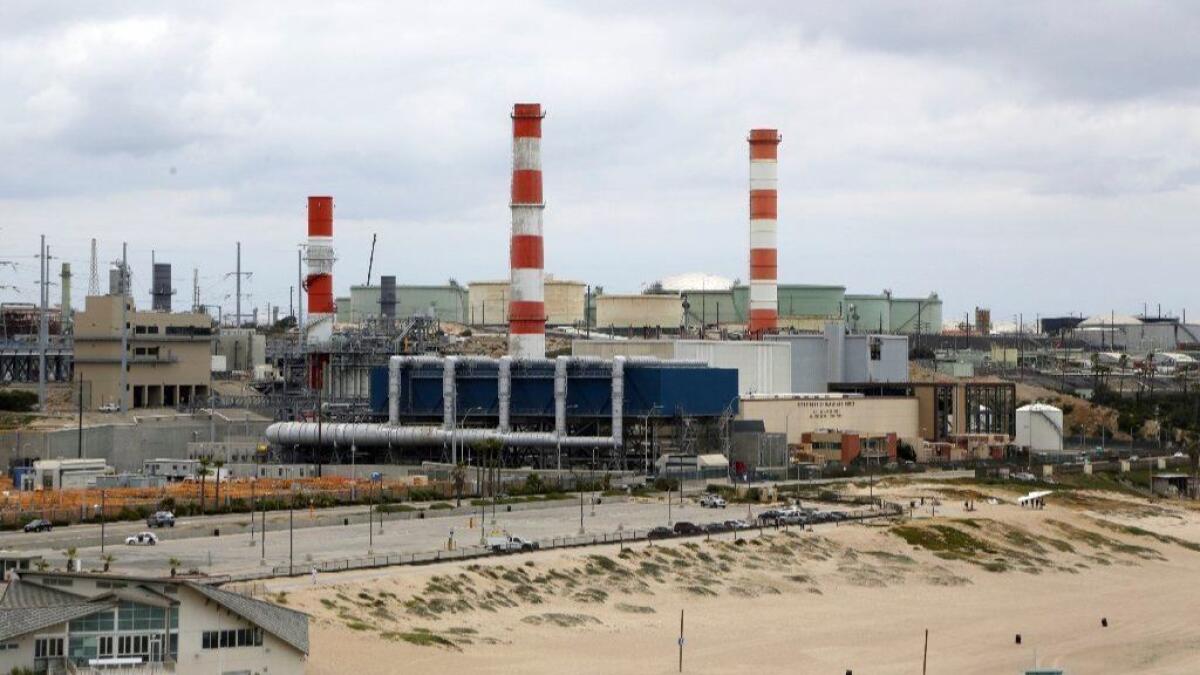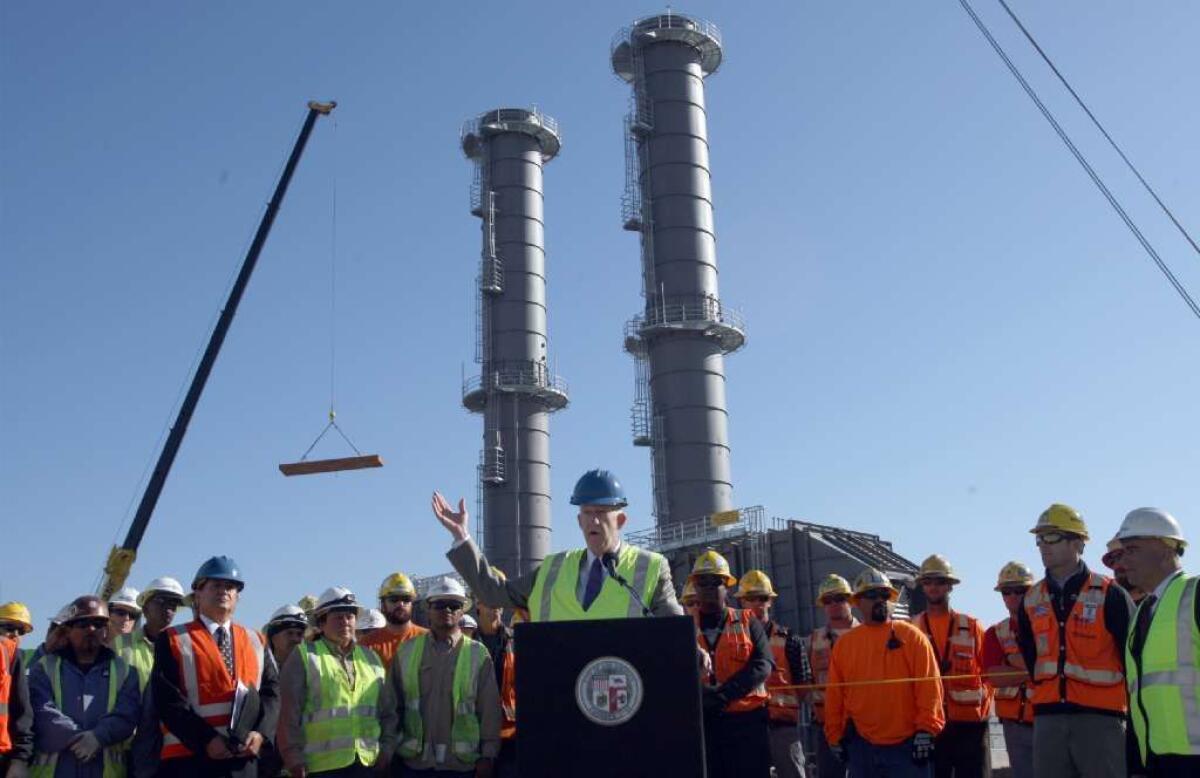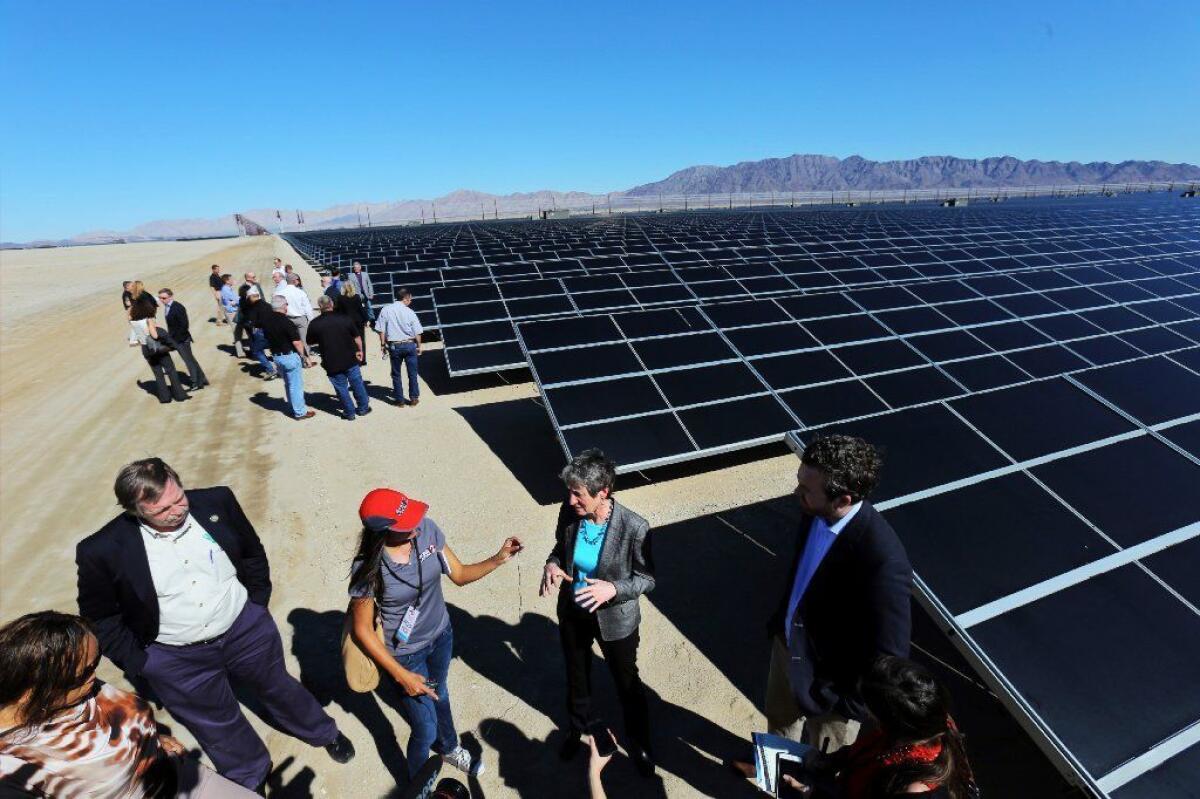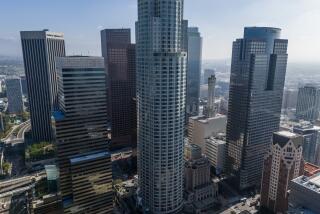California is aiming for 100% clean energy. But Los Angeles might invest billions in fossil fuels

- Share via
The Los Angeles Department of Water and Power is leaning toward spending billions of dollars to rebuild three aging gas-fired power plants, even as California aims to eliminate fossil fuels, a goal endorsed by Mayor Eric Garcetti.
Consultants hired by the utility say the city should invest those ratepayer dollars in continuing to burn natural gas at the Scattergood, Harbor and Haynes power plants along the coast. The utility’s staff agrees, saying that batteries charged with solar or wind power aren’t yet cheap or reliable enough to replace the gas plants, which are critical to keeping the lights on.
Environmental activists had cheered last year when the DWP said it would temporarily halt plans to rebuild the plants. Now they’re dismissing the consultants’ study because it doesn’t consider the possibility that battery costs, already far lower than they were a decade ago, will continue to fall.
Clean energy advocates say investing in fossil fuels runs counter to the state’s target of 100% climate-friendly energy by 2045, and the city’s commitment to zeroing out its planet-warming emissions by 2050.
At least one DWP commissioner feels similarly.
Aura Vasquez was appointed by Garcetti to the utility board last year after she helped convince city leaders to stop burning coal by 2025. She sees replacing the three gas plants with cleaner energy as critical to fighting climate change and reducing local air pollution.
The Scattergood and Harbor gas plants sit in communities with some of the worst pollution in California, state data show. Scattergood is in El Segundo just south of Los Angeles International Airport, and Harbor is in Wilmington by the ports of L.A. and Long Beach.
“I will not spend one more dollar repowering another gas plant that is making people sick in Los Angeles neighborhoods when we have viable alternatives,” Vasquez said in an interview.
L.A. keeps building near freeways, even though living there makes people sick »
DWP’s top energy managers say there are no viable alternatives in the short term, at least without increasing the risk of power outages among the 4 million people served by the municipal utility.
“We’re trying to maintain system reliability,” said Reiko Kerr, senior assistant general manager for power system engineering. “We could go to 100% renewables today if we want to accept more outages.”
California has ramped up its push for cleaner energy over the last two years, even as the Trump administration has rolled back climate change regulations. But policymakers and advocates in the state remain divided over how quickly the world’s fifth-largest economy should ratchet down its carbon emissions and how to measure the costs and benefits.
The Los Angeles-area gas plants are a flash point in that debate.
The country’s second-largest city got nearly half its electricity last year from energy sources that don’t contribute to climate change, including 30% from renewables such as solar, wind and geothermal; 10% from the Palo Verde nuclear plant in Arizona; and 4% from Hoover Dam and the Castaic hydropower plant north of the city. Some additional electricity came from hydropower facilities in the Pacific Northwest.
But nearly a fifth of L.A.’s electricity last year came from the Intermountain coal plant in Utah, which is scheduled to be decommissioned by 2025. And the biggest share of the city’s electricity, 31%, came from natural gas — most of which was burned at the Scattergood, Harbor and Haynes power plants as well as the Valley Generating Station in Sun Valley.

Consultants say L.A. should keep burning gas
Los Angeles is under state orders to shutter 10 gas-fired generating units at Scattergood, Harbor and Haynes that use ocean water for cooling, a process that can harm marine life. The use of so-called once-through cooling technology must end at Scattergood by 2024, and at Harbor and Haynes by 2029.
The city originally planned to replace the aging generators with newer, more efficient machines equipped with dry-cooling technology that doesn’t use ocean water. But the DWP paused those plans last year after a Los Angeles Times investigation revealed that California utilities had spent years building more gas plants than they needed to meet electricity demand, saddling ratepayers with billions of dollars in costs.
DWP’s energy managers thought then, as they do now, that there was no way to shut down the gas plants without sacrificing reliability. But at the urging of environmental groups, the utility hired a team of consultants, led by the Australian engineering firm WorleyParsons, to study whether Scattergood, Haynes and Harbor could be replaced with cleaner alternatives.
The consultants’ study won’t be finalized until early next year. But at a DWP board meeting last month, representatives from WorleyParsons and Navigant Consulting said Los Angeles should rebuild all five ocean-cooled generating units at Scattergood and Harbor, and two of the five units at Haynes.
The consultants recommended replacing three of the five ocean-cooled units at Haynes with a combination of energy storage, solar power and energy efficiency. They estimated the cost of those projects, plus the gas turbine replacements, at $3.4 billion — more than a billion dollars higher than the estimated $2.2-billion cost of rebuilding all three gas plants.
To replace all three gas plants with clean energy, the consultants said, the city could need 1,800 megawatts of energy storage — much more than any other utility has built so far — plus hundreds of miles of new power lines to import solar and wind power from outside the L.A. Basin.
“Our study is not an aspirational study. Our study’s a reliability-based study,” Don Morrow, a managing director of Navigant Consulting’s energy practice, told the board.

Gas plants vs. clean energy
Luis Amezcua, a senior representative with the Sierra Club’s Beyond Coal Campaign, said other utilities are doing more than DWP. He pointed to Southern California Edison, which is avoiding the need for a new gas plant in the L.A. area by investing in batteries and solar. Pacific Gas & Electric plans to replace three gas plants with energy storage, including two batteries that would be the largest in the world.
Other California utilities are “actually putting forward really creative solutions that involve clean energy and addressing the problem of reliability in other ways,” Amezcua said.
DWP’s managers say they are investing in innovative technologies, including a 20-megawatt lithium-ion battery plant near the city of Mojave.
But the physical reality of the utility’s power grid, they say, means gas plants will be needed for years to maintain reliable electricity. There’s limited capacity on the city’s aging power lines to import the renewable energy that would be needed to charge massive battery installations. There’s not enough space at the gas plant sites to install those batteries.
The utility is planning new transmission lines to import clean power from outside the L.A. Basin and to ease the flow of electrons on the city’s crowded local grid. But new infrastructure could take decades to permit and build, and the utility will need its gas plants to keep the lights on in the meantime, said Bill Barlak, DWP’s manager of system reliability studies.
“We are setting ourselves up for 100% renewables 25, 30 years from now. But there’s a lot that has to go on, and we need the [gas] generation in the medium term to do it,” Barlak said.
San Diego Gas & Electric to add five battery storage facilities »
Board member Vasquez thinks the city can be more of a leader in fighting climate change.
“Investing billions of dollars on repowering gas plants doesn’t seem to honor the commitment that Los Angeles has made to be the most renewable and solar and energy efficient city of California and the country,” she said.
The DWP board probably will decide early next year whether to fund an environmental analysis for the Scattergood repowering.
General manager David Wright told the board that the city has five additional years, until 2029, until it must replace Harbor and Haynes. That means the utility could revisit plans to rebuild those gas plants if the cost of solar power paired with battery storage looks more attractive in a few years.
“This isn’t the last bite at the apple,” Wright said.
More to Read
Inside the business of entertainment
The Wide Shot brings you news, analysis and insights on everything from streaming wars to production — and what it all means for the future.
You may occasionally receive promotional content from the Los Angeles Times.











